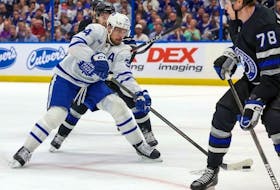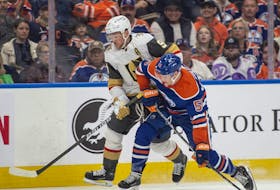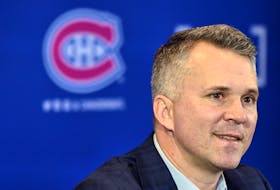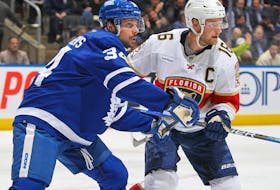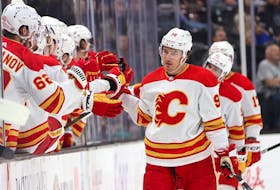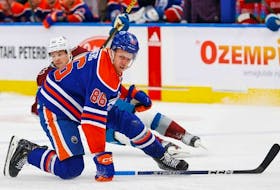
Royals clinched 7th Herder in 1984-85
In the 1985-86 season, the Corner Brook Royals became the first Newfoundland team to win the coveted Allan Cup, the symbol of Amateur hockey supremacy in Canada and considered by many to be second only to the NHL's Stanley Cup.
Newfoundland Senior Hockey League squads had been competing in the April Allan Cup playoffs since the mid-1960s. Danky Dorrington and the Royals had taken a couple of shots at the title in that decade but they, and the other island entries over the years, could never get further than the Eastern Canadian finals.
In the 1970s, the one chance that the Royals had for the championship was spoiled after the Herder winning Corner Brook team were defeated by the combined St. John's Blue Caps-Shamrocks for the right to represent the province. Indeed, the Royals would have been the last team anyone would have picked as Allan Cup favorites in the early 1980s.
The team, and the Corner Brook Hockey Association, struggled throughout this period with heavy financial burdens, low attendance, and lackluster on-ice play. The Royals returned to the N.S.H.L. in 1983-84 after sitting out for two years in order to recoup the debts it had incurred and the team, complete with new paid imports as was the practice in the league at that time, finished third overall but made it to the Herder finals where they were soundly defeated by the powerhouse Stephenville Jets.
Former Royals' goaltender Dave Matte was a key element in the team's championship years in the mid-80s. Here he accepts an award as the league's top goaltender from Claude Anstey, long time NAHA executive member.The hockey community in the city was determined to put together a winning team and in the next season, despite several early difficulties, the Royals finally lived up to expectations. They won the Herder and were the first to capture the Eastern Canadian championship but fans and players alike were shocked after they dropped four straight games in the Allan Cup finals. Even more appalling was the fact that they had been up three games to none in the series and were in the friendly confines of Humber Gardens.
Corner Brook, and the entire province, were still extremely proud of the team, but local hockey executives like Cliff Gorman and coach Mike Anderson were not satisfied with second best. After tireless efforts off the ice the Royals returned in 85-86 with an even stronger team and a mission. With then household names like imports Dan Cormier, Robbie Forbes, and Dave Matte as well as a seasoned and reliable local contingent the Royals captured their eighth Herder, went the distance before taking the Bolton Memorial Trophy for Eastern Canada, and then swept the Nelson Maple Leafs in British Columbia to become national champions.
The local players and honorary Corner Brook adoptees were welcomed home as conquering heroes and their victory remains unique in Newfoundland today. The Allan Cup became, for many in Corner Brook, not just a valued sports prize but a source of immense civic and personal pride. It put Newfoundland's "second city" on the map as first in Canada.
1984-85 was the 50th anniversary of the Herder Memorial Trophy. A number of festivities were planned for the occasion but the Royals organization started off the season in anything but a celebratory position.
Before they had even begun play the Royals returning player-coach Steve Robson resigned and returned to the mainland citing "personal reasons" and a lack of desire to do the job as his main reasons for quitting the post. Bobby Clarke, a star player for the Royals during the Dorrington era, took over as bench coach but he had his problems as well.
Five players, including veteran Terry Gillam, walked out on Clarke after only his first practice with the team. Comments were kept to a minimum in the local media but the dispute centered around Clarke's allegedly "rough" treatment of the players. Differences were smoothed over within a couple of days but it was clear that the team was not one hundred per cent focused.
Likewise, several key players from the previous seasons Herder finalists did not return. Robson, Danny Cuomo, and Tim Cranston were three of the imports who opted not to play for the team. The Royals did re-sign Tony White, Tony Cuomo, and Steve Gallant, and acquired the services of Whitney Richardson, a 21 year old from Nova Scotia, and highly touted netminder Dave Matte, a native of Ontario and a member of the 1982-83 Herder winning Cataracts team, in the preseason.
The Newfoundland Senior Hockey League was a four team affair in 84-85. The Royals joined the favoured two time champion Stephenville Jets, Port Aux Basques Mariners, and returning Grand Falls Cataracts in the tough 36 game regular season.# The playoffs would consist of all four teams. The first place finishers were to play those in third place, and number two was to be seeded against number four.
Early on the Royals played poorly. Defensive lapses hurt the team so the C.B.H.A. enlisted Stan Hennigar, a blocky defenceman from Halifax, to take some of the pressure off of the perpetually besieged Matte and local backup Kevin McCarthy.
Unfortunately, the move did little to spark the Royals to victory and they limped into the short Christmas break on a losing streak and fighting against the Mariners for second place. Cliff Gorman, the outspoken president of the C.B.H.A., by now in his 12th year in that capacity, did not mince words in his assessment of the team. He said, "the whole team was playing the sh_ts."
| Heroes of the Past |
| The following is a list of players who performed for Corner Brook in provincial senior hockey competition since play for the Herder Memorial Trophy began in 1935. 1979-80 Royals: (Failed to make playoffs) Jim Grant (Coach), Terry Gillam (Playing-Coach), Keith Holbrook, John Saunders, Danny Doyle, Juan Strickland, Kev Neville, Barry Grant, Mark Roberts, Craig Kennedy, Brent Griffin, Ray Baird, Keith Warren, Richard Parsons, Alex King, Alex Blanchard, Gordie McWhirter, Darren McWhirter, Lorin King, Rick Munden, Gary Feener, Alvin Park, Don Gushue, Chris Grouchy, Gordie Caines, Gary Bugden, Johnny Bugden 1980-81 Royals: (Defeated in Herder Finals by Grand Falls) Forbes Kennedy (Coach), Bruce Campbell, Cal Dunville, Terry Gillam, Darren McWhirter, Brian Jesso, Kent Lannon, Byron Rideout, Bill Perry, Ralph (Shack) Dunne, Mark Roberts, Brent Griffin, Wayne Targett, Kev Neville, Alex King, Craig Kennedy 1981-82 Royals: (Did not enter because of financial difficulties) 1982-83 Royals: (Did not enter the league) |
In December and early January the Royals picked up several sorely needed additions. Danny Cormier, a skilled forward, who had formerly played for the Moncton Golden Flames of the A.H.L., and Bill Breen, Bob O'Neil and Kirk Johnson of St. John's beefed up the lineup for the final regular season push. Coaching problems continued to plague the team however.
Bobby Clarke resigned early in the new year arguing that his contract, which was up for renewal, was not satisfactory. The hockey association, not prepared to meet Clarke's demands, hired Mike Anderson, a former N.S.H.L. player with the Royals and Gander Flyers.
In turn, Anderson appointed veteran Tony White as his playing assistant. With these new players and coaching changes the Royals seemed to settle down and began to play good fundamental hockey. They were much improved in the second half of the schedule, ending up with a 20-13-3 record. Corner Brook easily outpaced the Mariners for second place but remained 15 points behind the first place runaway Jets. Accordingly, the Royals were set to face the despondent, cellar dwelling Cataracts in the best three of five games semi-final playoff series.
The first game of the Royals/Cataracts series, played at Humber Gardens, was special for many Corner Brook fans. Being the 50th anniversary of Herder competition the four surviving members of the first championship team were honoured by the N.A.H.A. and C.B.H.A. at a pre-game ceremony. In front of over 1,000 spectators, Fred Power, Jack Marks, Harold Cross, and Harold Power (who was absent from the proceedings), members of the 1935 Corner Brook team, received plaques from N.A.H.A. president Claude Anstey and Cliff Gorman commemorating their involvement in those historic games.
In the ensuing match, the Royals easily defeated Grand Falls to take a 1-0 series lead. The second home game for the Royals was won handily as well and the Cataracts were eliminated in game three on their home ice. In Bruce Arena on the southwest coast, the Mariners were also eliminated in their series against the Jets in three straight games. The opponents had been decided. The Royals and the reigning champion Jets would have a finals rematch for the half century old prize.
Indeed, the Royals were fighting an uphill battle. Not only were they facing the best team in the league and lacking the advantage of home ice, but the Jets had generally had their way with Corner Brook all season long. The Royals had only won three and tied one of the twelve regular schedule meetings with Stephenville. All indications pointed to a third consecutive title for the boys from the airport town.
However, the Royals laid doubt to rest after a win in game one. Game two went to the Jets, but the teams were returning to Humber Gardens tied. "Herder fever" had gripped the two west coast sites. Three hours after tickets went on sale for games three and four the stadium was sold out. In fact, it was reported that people were buying the normally $6 tickets from scalpers for upwards of $20. One writer said that, "The interest is permeating to the core of each community's existence."
Everyone wanted to see what was fast becoming one of the greatest rivalries in the history of Newfoundland hockey.
The third game went to the Royals, but the Jets kept the series deadlocked with a win in the fourth game. The close games were nerve-wrecking for players, organizers, and fans alike. In game four the frustrated spectators at Humber Gardens threw piles of debris on the ice, and a bench-clearing brawl, instigated by Jets president and general manager John Parsons, erupted in the third period.
The close and exciting competition resumed in Stephenville Gardens in Game 5 where the Royals pulled out a victory to go up three games to two in the series.
Back at Humber Gardens once more the home team was determined to return the Herder to its original residence and Terry Gillam, a 15-year veteran and the only member of the team who had previously won a Herder with the Royals, banged in the game winner.
The Jets had been dethroned as the best senior team in Newfoundland and the Royals celebrated their first provincial title in eight years and their seventh overall.
The history of hockey in Corner Brook, researched by Neil White for the Newfoundland and Labrador Hockey Hall of Fame covering the period from
the 1920s up to 1990.
The series of articles was first published in The Western Star from December
2000 to May, 2001.
To buy a reprint of this page as it appeared in The Western Star email [email protected]

